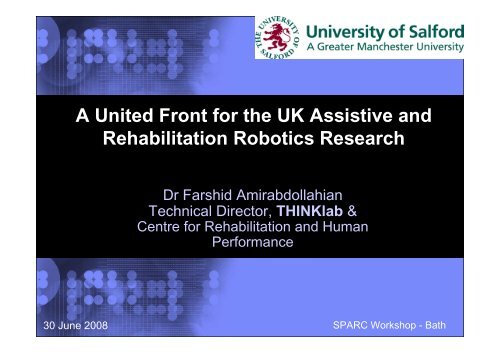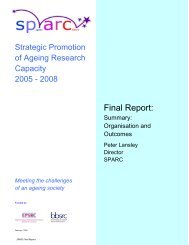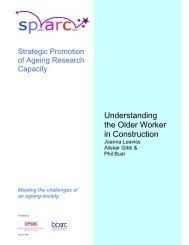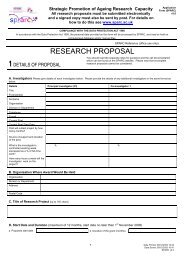Rehabilitation Robotics Research
Rehabilitation Robotics Research
Rehabilitation Robotics Research
Create successful ePaper yourself
Turn your PDF publications into a flip-book with our unique Google optimized e-Paper software.
A United Front for the UK Assistive and<br />
<strong>Rehabilitation</strong> <strong>Robotics</strong> <strong>Research</strong><br />
Dr Farshid Amirabdollahian<br />
Technical Director, THINKlab &<br />
Centre for <strong>Rehabilitation</strong> and Human<br />
Performance<br />
30 June 2008<br />
© 2002 IBM Corporation<br />
SPARC Workshop - Bath
Today’s Presentation<br />
• Brief Introduction to THINKlab & Centre for<br />
<strong>Rehabilitation</strong> and Human Performance<br />
• Example <strong>Research</strong> Project, GENTLE/S<br />
• Why do we need a united front for assistive<br />
and rehabilitation robotics research?
THINKlab – Space for support innovative research
Centre for <strong>Rehabilitation</strong> & Human<br />
Performance
Facilities: Gait & Human Performance Lab<br />
Mary Seacole Building<br />
This is our principal gait and human performance laboratory and offers a large space (30m x 12m)<br />
within which a wide range of activities can be supported.<br />
The lab can also be divided into three separate sections to support parallel activities.<br />
The central area is designed for walking studies and general motion capture. The lab also has<br />
isokinetic, ultrasound imaging, treadmill, cycle and rowing facilities plus gas analysis and other human<br />
performance measures.<br />
In addition, there is a 30m running track surface along the length of one side of the lab.
POET Project, Posture measurement<br />
The aim of this study is to develop a clinician and patient friendly measurement device that<br />
measures posture of post-stroke patients in a clinical environment. The final product will be<br />
portable, easy and convenient to use, and suitable for a wide range of patient. Inertial sensors<br />
will measure orientation of the head, trunk and pelvis in three dimensions, while a lightweight<br />
force plate will measure weight distribution through the buttocks and feet in sitting and<br />
standing. Pattern analysis techniques will be used to present results that can be used<br />
immediately for clinical decision making.<br />
© 2002 IBM Corporation
Healthy Aims Project<br />
Healthy Aims, an EU Framework VI project securing over 16M Euro of funding<br />
over 4 years for the 26M Euro project. There are 26 partners, including 6 SMEs,<br />
across 9 EU countries. These partners have developed a range of medical implants<br />
to help the aging population and those with disabilities.<br />
Our role was to develop an FES for the upper limb device to aid reach, grasp &<br />
release tasks for post-stroke patients.<br />
Salford has been collaborating with Finetech Medical and Odstock Medical to develop<br />
and validate software for the control of upper limb FES.<br />
© 2002 IBM Corporation
FES Stimulator Development<br />
Our team at Salford collaborated with a team in Sheffield to develop a multi-channel, electrode-array based stimulator that<br />
addresses the problems with the current single channel technology. The stimulator is to aid walking for post-stroke patients<br />
with drop foot.<br />
• We have investigated the effect of the properties of the hydrogel layer that interfaces between the electrode array and the<br />
skin, on stimulation selectivity and sensation. We identified that a high resistivity layer improves both stimulation selectivity and<br />
reduces sensation felt by the user during stimulation.<br />
• We are developing a technique for rapid searching of the electrode array to identify the optimal virtual electrode (active<br />
subset of 64 electrode array) that when stimulated results in appropriate foot motion at low current<br />
© 2002 IBM Corporation
Example <strong>Research</strong> Project to rationalise the<br />
need for a national united front<br />
GENTLE/S Robot Mediated Upper Limb Neurorehabilitation<br />
system<br />
© 2002 IBM Corporation
Living Pulse, Discovery Channel
The Gentle/s consortium<br />
•Partners<br />
– University of Reading, UK - <strong>Research</strong> and coordination<br />
– Zenon, Greece - Industrial<br />
– Trinity College Dublin, Ireland - Clinical<br />
– TNO Institute of Applied Physics, Netherlands - <strong>Research</strong><br />
– Newcastle University, UK - <strong>Research</strong><br />
– University of Ljubljana, Slovenia - <strong>Research</strong><br />
– Rehab <strong>Robotics</strong> Ltd, UK - Industrial<br />
– Virgo, Greece - Industrial<br />
– Staffordshire University, UK - <strong>Research</strong><br />
• Subcontractors: Royal Berkshire Hospital, UK - Clinical
GENTLE/S<br />
• Funded by the EU<br />
• Framework 5, Quality of Life<br />
• KEY ACTION 6: The Ageing Population and<br />
disabilities<br />
•2.6 M€<br />
• A project to evaluate robot mediated therapy in<br />
stroke rehabilitation for elderly
Different disciplines and expertise involved<br />
•User groups<br />
– Trial patients, advisory groups, patients’ families<br />
•Clinicians<br />
– Consultants, physiotherapists, occupational therapists<br />
•Engineers<br />
– Control, Mechanics, Biomechanics, <strong>Robotics</strong>, Design<br />
•Computer Science and VR experts<br />
•Statisticians<br />
•Commercialisation experts
Initial thoughts
First Prototype<br />
•PER-Force 6DOF Robot Manipulator
User requirements<br />
•Workshop with Staffordshire young<br />
stroke group, clinicians & engineers<br />
slide<br />
Y<br />
Shoulder support mechanism overhead<br />
X<br />
tensators<br />
slide<br />
F comp1<br />
F comp2<br />
Z<br />
Centre of Gravity<br />
Upper arm<br />
Centre of Gravity<br />
Forearm<br />
Figures Courtesy of TNO-TPD, Delft, the Netherlands<br />
Y
Figure Courtesy of Staffordshire University and RehabRobotic
Gimbal end-effector<br />
GENTLE/S Gimbal Design, courtesy of University of Reading
Royal Berkshire Hospital system, Prototype 2.1
Dublin System, Prototype 2.2
Exercise environments
Figure Courtesy of Staffordshire University and Rehab<strong>Robotics</strong>
Pre-Commercial reincarnation
Immersion and motivation<br />
Developments by Virgo, Greece
Interactive and engaging environments<br />
Developments by Virgo, Greece
GENTLE/S trial<br />
•31 hemiplegic subjects, 3+ month past<br />
stroke<br />
•26 to 28 sessions<br />
•Three phases per patient<br />
– A – Baseline<br />
– B – Robot (9 sessions)<br />
– C – Sling suspension (9 sessions)<br />
•Patients were randomised into ABC or<br />
ACB groups
Fugl-Meyer outcome measure for one patient in ABC group<br />
Analysis of one subject, Farshid Amirabdollahian
Summary of results<br />
Results summary, Farshid Amirabdollahian.<br />
Special thanks to GENTLE/S Clinical Partners in Dublin and Reading for providing clinical measurements for this study.
What was learned from it?<br />
• GENTLE/S seems to be able to contribute to recovery 3<br />
months post stroke<br />
Areas for improvement:<br />
• Larger number of patients, improve statistical power<br />
• Early intervention<br />
• Longer exposure<br />
• More function oriented therapies<br />
• Involvement of hand and grasping<br />
• More bio-feedback on how a patient does during a session<br />
• 1 and 2 month post trial assessment<br />
• Double blinding during clinical assessment<br />
• Better design for the study (carry over effects can not be<br />
eliminated due to lack of stable baseline)
Wish list continues<br />
•Shaping and motivational therapies<br />
•Device for use at home<br />
•Real-time analysis of the performance
Now the main topic: why a united front?<br />
EPSRC NETWORK FOR<br />
ASSISTIVE & REHABILITATION<br />
ROBOTICS
Why a network?<br />
• Slow rate of progress<br />
Although safety, robustness and flexibility are improved, price is still a<br />
major barrier<br />
• We need to convince industries and users<br />
• Paradox:<br />
Lack of adequate evidence for usefulness => relatively small demand =><br />
little funding => lack of adequate evidence<br />
• Multidisciplinary nature of the problem and lack of sufficient linking<br />
between different disciplines<br />
• Weak dissemination => inadequate public awareness (industries,<br />
governmental bodies, other Universities, international collaborators,<br />
users)
Possible solutions<br />
•Stronger multidisciplinary links<br />
•Strong successive chain of usefulness<br />
evidence<br />
•Strong dissemination<br />
•Stronger commercialisation<br />
core members with 300 peer reviewed papers, £16M funding and 48<br />
PhD students, perhaps a more coordinated approach can make the evidence<br />
more powerful
Current Network Members<br />
• University of Salford, Dr Farshid Amirbdollahian (PI), Prof David Howard, Dr Laurence<br />
Kenney, Dr Sarah Tyson<br />
• The University of Reading, the Human Robot Interface lab (THRIL) – Prof William<br />
Harwin & Mr Rui Loureiro<br />
• The University of Newcastle, Centre for <strong>Rehabilitation</strong> and <strong>Robotics</strong> Studies (CREST)<br />
-Prof Garth Johnson<br />
• Queen Margaret University – Dr Frederike van Wijck<br />
• Keele University - Dr Anand Pandyan<br />
• NHS Grampian, Aberdeen - Dr Alastair Cozens<br />
• University of Leeds - Prof Bipinchandra Bhakta & Prof Martin Levesly<br />
• University of Bath, Bath Institute of Medical Engineering - Dr Michael Hillman & Prof<br />
Roger Orpwood<br />
• Imperial College London - Dr Anthony Bull & Dr Etienne Burdet<br />
• University of East London – Prof Duncan Turner<br />
• Sheffield Hallam University – Prof Gail Mountain<br />
• Southampton University – Dr Jane Burridge, Ann-Marie Hughes, Eric Rogers,<br />
Christopher Freeman, Paul Lewin and Paul Chappell<br />
• University of Bristol and University of West of England – Prof Chris Melhuish, Dr<br />
Anthony Pipe, Dr Ravi Vaidyanathan, Dr Kevin Foreman & Dr Ailie Turton<br />
Prof Yu from Staffordshire University on external advisory role
Current members<br />
Possible future members
Network Objectives<br />
• A. A united front for the UK’s assistive and<br />
rehabilitation robotics research<br />
• B. Website and dissemination<br />
• C. National and international meetings, workshops<br />
and conferences<br />
• D. Interdisciplinary project proposals<br />
• E. Resource exchanges<br />
• F. Knowledge transfer<br />
• G. Link with industries, existing networks and<br />
initiatives
Network Activities<br />
• 1. Preparation of a short-term and long-term research roadmap<br />
• 2. Production of a website (http://rehabilitationrobotics.net )<br />
• 3. Preparation of at least 4 flagship project proposals during<br />
the life of the network<br />
• 4. Organising regular meetings/workshops<br />
• 5. Session sponsorship at ICORR2009 conference<br />
• 6. Visiting scholar programme<br />
• 7. Publication of a series of White Papers<br />
• 8. Attracting new members<br />
• 9. Links with existing networks and initiatives<br />
• 10. Link with existing industries
Establishing these links:<br />
•Linking with HAM UK-Japan network<br />
•Link with FAST-UK<br />
•Link with National Stroke Association, CP and other<br />
•Link with SMART and SMART 2 consortia<br />
•Link with NHS Technology HUB<br />
•Links with regional medical physics groups, teaching<br />
hospitals and other clinical entities near each member<br />
institute
•Thanks for inviting me<br />
•Thanks for listening<br />
•Any questions?<br />
Special Thanks to Prof Harwin and Dr Nester for providing permission to include this content on the web.









